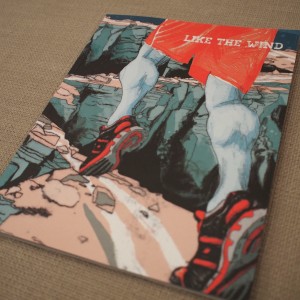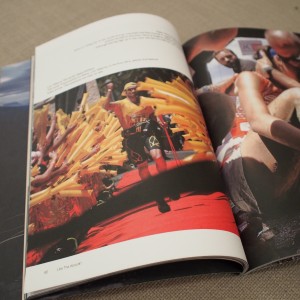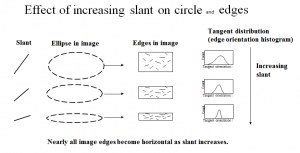When I first entertained the thought of running at the ultra distance, I told myself I would only ever run on the road. There is one problem with this however, as not many ultras are run on the road – they are predominantly trail-based events. I avoided the idea of running on trails for as long as I could. But the longer you dream of ultras the idea of running trails comes to the forefront. I decided to bite the bullet and enter a trail race, the SDW50 – a 50 mile run across the South Downs Way.
So I could get used to running trails I decided to enter a half trail marathon – the Osmotherly half trail marathon. After speaking to the race director he assured me the trail could be easily run by a blind runner. Encouraged by this, I linked up with a guide runner from down south and we had arranged to run this race together. I have never run a true trail event, and Braddan had never acted as a guide runner, so this was going to be a true challenge for both of us.
Stood on the start line we were looking forward to the race ahead. We had decided to start right at the back, so we could get used to the guiding without hindering other runners. The race started off on a relatively easy road section, with the only issue being a little ice here and there. We quickly entered the true trail sections and we were instantly hit by the difficulty of the terrain. It was a deeply rutted split track, meaning there were 2 dipped tracks with a raised section in between. Neither track was wide enough for 2 runners, which meant I had to drop in behind. This gave Braddan the difficult job of shouting out possible obstacles I may encounter. We were quickly brought down to a walk for 2 reasons; i) I suck at hills, and ii) the terrain was becoming difficult to describe simply. It didn’t take long, however, until the terrain levelled out and we returned to Braddon giving short instructions of what to expect.
Running through deep puddles and even deeper mud puddles we were beginning to have fun. While the terrain was difficult it remained entertaining and we laughed and joked as we ran along. With pieces of the track narrowing I had to attempt to be as precise as possible while trailing Braddan. This proved too difficult a little way down the trail and my left foot slipped and I began to fall. With cat like balance and dexterity I remained upright, and triumphant in my gymnastic-level balance we plodded on. We arrived at a truly difficult section – a section I remember being warned of.
As a blind runner, in my mind’s eye it felt like we were descending down a trail version of a pyramid. I remain convinced an excavation of the trail would reveal a lost egyptian temple. This section was incredibly difficult and I noted to Braddan that my leg was beginning to hurt, my cat like balance from earlier had come at the price of a little twinge. We plodded on and even managed to get into a little flow of running. The trail weaved in and out of woods, fields and a little road. After a particularly tricky downhill section in the woods we found ourselves in a field. Braddan says it was a field – I believe it was an ice rink. The “mud” as Braddan called it was like sheet ice. I constantly slipped and slid around the rink and we finally reached the bottom. At the bottom Braddan gave me a choice – run through a river or take the bridge. This seemed like a no brainer. Let’s take the bridge!
With my first step onto the bridge I nearly fell, saved only by Braddan managing to give me an arm before I fell. We quickly decided running through the river was the better choice. We continued running and made reasonable progress until another uphill section through the woods. As we went through a gate we found another pyramid. This time we would have to ascend it – walking up a pyramid is just as hard as coming down one! After a while we made it to the top, only to discover it was the start of a big climb. The hill was far too difficult for a novice trail runner and a novice guide, so we decided to walk. Around this point all the quick runners began to pass us by. Somehow we had been reasonably close to everyone as the turnaround point was around 1 mile away. We believed everyone must have gotten lost and that is why we had made such a reasonable time. After a lot of plodding and becoming the last 2 runners in the race we reached the turnaround point. So now we had to do a lot of it again!
Running down the hill we got into a really good flow, we had shortened the guiding communication down and we were running/walking smoothly across the top of the hills. We were quickly brought down to earth by the descent and Braddan fell over. Now I saw he fell over – I might of pushed him a little, I assumed he had cat balance! Arriving atop the pyramid, we now had to descend it – this is where it all fell apart. My twinge had now turned into outright pain. I was struggling to put any weight on my leg and from this point we had another 5-6 miles. Determined, I wanted to move on.
Our speed had reduced to a crawl, I was struggling to bend my left leg. I was beginning to hoddle when a marshall arrived, “are you injured?” Me? No, of course not! However, this lie couldn’t be held up for long, as the marshall said they would come along with us to the finish line. It only took a couple of hundred metres before I had to admit to being in quite substantial pain. I had assured her I wanted to continue and she seemed happy to let me push as far as I wanted to. While attempting to numb the pain with a little fast walking we had become lost, as it appeared had a whole bunch of other runners. After realising our mistake we doubled back – a little disheartening to discover you have gone the wrong way when injured, but this was made a little easier by the fact that so had everyone else!
Arriving back at the ice rink was my first real challenge. I was unable to bend my leg while ascending or descending and the rink was on a slope. So only able to bend my right leg I hobbled to the top. Arriving at the top of the rink there was a nice undulating section through the woods. A great chance to push the walking pace and numb my leg. This proved a great idea and we began to make decent time. I was quickly brought back down to my one legged shuffle when we arrived at a series of steps. Unable to manage the pain effectively I had to continually rest. However, this simply made the problem worse, for every time I stopped the pain would just increase when I started again. I told Braddan and the marshall not to let me stop again, no matter how much I complained about the pain. After 4 steps I said we have to stop it’s too painful. Sticking to their guns they didn’t allow me to stop, and I made it to the top after a few minutes.
This gave me a further opportunity to numb my leg – with an undulating surface I could pick up the pace and stop my leg from hurting. Worried I wouldn’t make the cut off I began asking the time constantly. The marshall assured me I would be allowed to finish even if I missed the cut off. I put on a brave face as I entered the checkpoint and made it through – I grabbed a handful of Jelly Babies with the idea I would reward myself every so often to keep me going. It was a slightly different route to the finish and this involved an enormous climb. I could only return to my one legged shuffle, and so it was taking me a long time to ascend this short section. The pain was now obvious on my face as other runners began to comment. I say my face, but it may have been the fact I was shouting out in pain. A very kind runner stopped and offered me his hiking poles to help with the ascent. I gratefully accepted them and continued my shuffle. By this time the pain was at the point of unmanageable, but I still had a few miles to go. I had already told myself I would finish, I just now had to continue to push. Reaching the top I rewarded myself with a Jelly Baby. The route continued to undulate and I had brief moments where I could numb my leg intersected with deep mud holes that brought the pain back. I continued to motivate myself with a Jelly Baby here and there.
After a short while another runner passed by and asked if I wanted some pain relief. I replied with “give me everything you have!”. Thankfully he was a nurse so gave me the appropriate dosage rather than me popping numerous tablets. I swallowed the pills with a Jelly Baby chaser and continued on. The route continued to be difficult for me with me stumbling over rocks and becoming stuck in the muddied track. I kept asking if we were close, I was assured we were, so I plodded on. We arrived at a field which the marshall proclaimed – “Oh, I forgot about this bit!”. Perhaps we weren’t that close after all. Leaving the muddy field I ate another Jelly Baby, but I was now getting low, I had to ration from this point on. I could feel the surface underfoot beginning to harden, I knew we couldn’t be too far from the village and the finish.
After a short while we turned a corner onto a road. This meant the finish was close by, I ate my penultimate Jelly Baby and decided to keep my last one for crossing the finish. Dodging a few cars and weaving in and out of the road and pavement we arrived at the finish line. I limped over the line, ate my final Jelly Baby and picked up my medal. It was only then I realised just how slow I had been moving, for the last few miles I had been averaging just over 1mph. My straight legged shuffle had been a long fought out slog to the finish. I was happy just to get to the end and importantly learnt some valuable lessons along the way.
The margin of error running the road can be measured in metres, the margin of error in the trail is measured in centimetres. One misaligned foot fall had caused me to stumble down a gradient and hampered my ability to compete. It taught me that if I am to conquer trail running as a blind runner I really need to tighten up how I run the trail. I think the only way I can achieve this is with a dedicated trail guide runner. That would give us an opportunity to develop a guiding relationship where the communication can be distilled to a couple of words and we both know exactly what that means in terms of me avoiding obstacles, While I spend the next week or so healing I am going to take the opportunity to realign my trail goals for the next year, with the aim to develop my ability on such terrain before entering the ultra trail distance.
I would like to say a massive thank you to Braddan for guiding me along the way and Kerry (the marshall) for letting me finish despite the limp. I would also like to thank the anonymous runners that stopped to help with equipment and pain relief.



